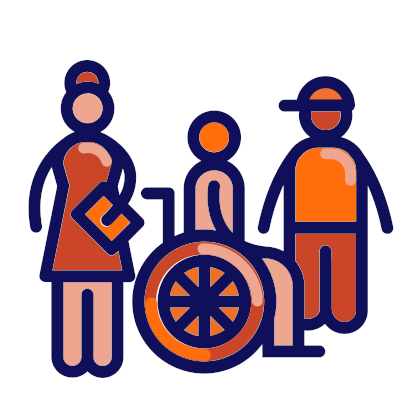Improving well-being at school

Since well-being has many facets, improving students’ well-being in schools requires a whole-school approach, involving both teachers and parents.
Schools should provide lessons focused on the responsible use of the Internet, the need to adopt a healthy lifestyle and how to prevent or cope with health problems, in collaboration with those involved, including health and social services, local authorities and civil society organisations.
Facts & figures
About 60% of school students report getting very tense when they study.[1]
Just over 60% of girls and 40% boys say they feel very anxious about doing tests at school, even when they are well prepared.[2]
Over 70% of parents say they would choose to send their children to a school with below-average exam results if students were happy there.[3]
What is well-being?
Well-being is the experience of health and happiness. It includes mental and physical health, physical and emotional safety, and a feeling of belonging, sense of purpose, achievement and success.
Well-being is a broad concept and covers a range of psychological and physical abilities. Five major types of well-being are said to be:
- Emotional well-being – the ability to be resilient, manage one’s emotions and generate emotions that lead to good feelings
- Physical well-being – the ability to improve the functioning of one’s body through healthy eating and good exercise habits
- Social well-being – the ability to communicate, develop meaningful relationships with others and create one’s own emotional support network
- Workplace well-being – the ability to pursue one’s own interests, beliefs and values in order to gain meaning and happiness in life and professional enrichment
- Societal well-being – the ability to participate in an active community or culture.
Overall well-being depends on all these types of functioning to an extent.[4]
“Having meaning and purpose is integral to people’s sense of well-being. Well-being involves far more than happiness, and accomplishments go far beyond test success.”[5]
Why is well-being important at school?
Well-being is important at school because schools have an essential role to play in supporting students to make healthy lifestyle choices and understand the effects of their choices on their health and well-being. Childhood and adolescence is a critical period in the development of long-term attitudes towards personal well-being and lifestyle choices. The social and emotional skills, knowledge and behaviours that young people learn in the classroom help them build resilience and set the pattern for how they will manage their physical and mental health throughout their lives.
Schools are able to provide students with reliable information and deepen their understanding of the choices they face. They are also able to provide students with the intellectual skills required to reflect critically on these choices and on the influences that society brings to bear on them, including through peer pressure, advertising, social media and family and cultural values.
There is a direct link between well-being and academic achievement and vice versa, i.e. well-being is a crucial prerequisite for achievement and achievement is essential for well-being. Physical activity is associated with improved learning and the ability to concentrate. Strong, supportive relationships provide students with the emotional resources to step out of their intellectual ‘comfort zone’ and explore new ideas and ways of thinking, which is fundamental to educational achievement.
Well-being is also important for developing important democratic competences. Positive emotions are associated with the development of flexibility and adaptability, openness to other cultures and beliefs, self-efficacy and tolerance of ambiguity, all of which lie at the heart of the Council of Europe Reference Framework of Competences for Democratic Culture.
What are the challenges?
One of the challenges of trying to promote young people’s well-being in school is the multi-faceted nature of well-being. There are a number of different types of well-being, all of which need to be promoted to some extent to create an overall sense of well-being in a person. So, it is not possible to improve students’ well-being at school through single interventions or activities. Rather it requires the development of a ‘culture’ of well-being throughout the whole school and the active involvement of the whole staff, teaching and non-teaching, which can be difficult to achieve.
The promotion of well-being may sometimes appear to conflict with other school priorities, such as academic standards. Unreasonably high expectations, a regime of constant testing or an over-emphasis on the importance of academic performance may actually undermine student well-being.
In many cases schools do not have the freedom to make the changes to school life which might most benefit student well-being. They may have little control, for example, over formal examinations and tests, the content of curricula, the length of the school day or the physical school environment.
Nor have schools control over the many out-of-school influences on student well-being. What happens in the home and the family, local communities or social media can have as much, if not more, influence on student well-being as anything in school.
Finally, developing a sense of well-being in students is made all the more difficult when school staff themselves do not have a positive sense of well-being. Well-being at work is strongly related to stress. Stress at work is related to workload, quality of professional relationships, level of autonomy, clarity about one’s role, availability of support and the opportunity to be involved in changes which affect one’s professional life. High levels of stress can lead to demotivation, lack of job satisfaction and poor physical and mental health, which has a knock-on effect on students’ own well-being.
How can schools get active?
Addressing student well-being at school begins with helping students feel they are each known and valued as an individual in her or his own right, and that school life has a meaning and purpose for them. This can be achieved in a variety of small ways, the cumulative effect of which can have a very powerful influence on students’ sense of well-being. These include:
- providing opportunities for all members of the school community to participate in meaningful decision-making in school, e.g. through consultations, opinion surveys, referenda, electing class representatives, student parliaments, focus groups, in-class feedback on learning activities, and an element of student choice in relation to topics taught and teaching methods used;
- developing a welcoming environment where everyone at school can feel supported and safe through access to meaningful activities, e.g. clubs, societies, interest groups and associations dealing with issues of concern to young people, including health;
- taking steps to reduce the anxiety students feel about examinations and testing through the introduction of less stressful forms of assessment, e.g. formative assessment, peer assessment and involving students in the identification of their own assessment needs;
- using teaching methods that contribute to a positive classroom climate and well-being, e.g. cooperative learning, student-centred methods, self-organised time, outdoor activities;
- finding curriculum opportunities to talk about well-being issues with students, e.g. healthy eating, exercise, substance abuse, positive relationships;
- integrating democratic citizenship and education for intercultural understanding into different school subjects and extra-curricular activities, e.g. openness to other cultures in Religious Education, knowledge and critical understanding of human rights in Social Science, empathy in Literature;
- introducing student-led forms of conflict management and approaches to bullying and harassment, e.g. peer mediation, restorative justice;
- improving the physical environment of the school to make it more student-friendly, e.g. new furniture and fittings, carpeted areas, appropriate colour schemes, safe toilet areas, recreational areas;
- encouraging healthier eating by providing healthy options in the school canteen, e.g. avoiding high amounts of sugar, saturated fats and salt;
- working with parents to enhance students’ achievement and sense of purpose in school, e.g. on healthy food, safe internet use and home-school communications.
Individual initiatives like these can be brought together at the whole-school level through a policy development process which ‘mainstreams’ well-being as a school issue. This means giving attention to the potential effects of new policies on individual well-being - of students, teachers and others. Addressing student well-being at school always goes hand in hand with action to protect the health and well-being of teachers and other staff at school.
[1] OECD (2017). PISA 2015 Results (Volume III), p.40. Students’ Well-Being. Paris, France: OECD Publishing.
[3] Cowburn & Blow, ‘Wise up - Prioritising wellbeing in schools’
[4] Psychology Today, January 2019.
[5] Hargreaves & Shirley (2018), ‘Well-being and Success. Opposites that need to attract’.
 Resources on Improving well-being at school
Resources on Improving well-being at school
 Related schools projects
Related schools projects
Address: Via Diego d’Amico 1 Bagheria
Country: Italy
Project: Children’s Voices for a new human Space - CVS
 Working language during the project:
Working language during the project:
- English
- Italian at local level
 Themes of the Council of Europe project “FREE to SPEAK, SAFE to LEARN - Democratic Schools for All” covered:
Themes of the Council of Europe project “FREE to SPEAK, SAFE to LEARN - Democratic Schools for All” covered:
- Making children’s and students’ voices heard
- Improving well-being at school
 Competences from the Reference Framework of Competences for Democratic Culture (CDC) addressed and where / how they were integrated:
Competences from the Reference Framework of Competences for Democratic Culture (CDC) addressed and where / how they were integrated:
- Making children’s and students’ voices heard
- Improving well-being at school
 Target group age range:
Target group age range:
- 5 - 11
 Level of education:
Level of education:
- Primary education
Short description of the project:
European societies have been facing significant challenges, such as a decline in citizen engagement with democratic processes, an increase in international flows of migrants, high levels of hate crime; intolerance, prejudice and discrimination towards ethnic/religious minorities living within Europe; a rise in xenophobic political groups, and the ongoing security threat posed by radicalisation and violent extremism. In this context, launching activities aimed at promoting European values, intercultural understanding, and citizens’ participation in public life, will make an invaluable contribution to the quality of life in Europe.
The CVS project is based on the idea that participation in democratic societies is essential to reduce the negative impact of these trends, and that young people have to be encouraged to think about the environmental, social and economic problems affecting their lives.
The CVS project builds upon a larger project of the CoE, “Reference Framework of Competences for Democratic Culture” (RFCDC), which has developed a new reference framework of the democratic and intercultural competences that citizens require to participate effectively in democratic culture and intercultural dialogue. Democratic and intercultural competences are not acquired automatically but instead need to be learned and practised, and education has a key role to play in preparing students for life as active democratic citizens and endowing them with the ability to function as autonomous social agents capable of choosing and pursuing their own goals in life. The RFCDC is designed to assist educational planning towards this goal of empowering learners for life as competent democratic citizens.
In order to achieve the project objectives, a variety of activities will be carried out:
- the development/implementation/testing of the CVS Training Course for teachers, aimed at improving teachers’ knowledge about pedagogical methods and techniques they can use to promote their pupils’ democratic and intercultural competence;
- the development/implementation/testing of the CVS Curriculum for children, aimed at fostering pupils’ democratic and intercultural competence;
- the development/implementation/testing of the CVS Supervision App for teachers, aimed at allowing the online methodological supervision of teachers’ activities;
- the planning/implementation of the CVS Study, aimed at evaluating the efficacy of the CVS Training Course for teachers, the CVS Curriculum for children and the adequacy of the CVS Supervision App for teachers as an IT tool for assisting teachers’ supervision;
- two short-term joint staff training events addressed at teachers: the first event will be aimed at implementing the CVS Training Course, the second event will be aimed at implementing a training programme focused on the CVS Curriculum for children and the use of the CVS Supervision App for teachers;
- a short-term exchange of groups of pupils, aimed at increasing pupils’ collaboration with peers of partner schools and allowing them to share their experiences;
- a series of multiplier events at local and transnational level, aimed at disseminating the intellectual outputs foreseen by the project.
Direct beneficiaries of the project will be about 30-35 teachers and 200-250 pupils of 5 European public primary schools (located in Bulgaria, Italy, Norway, Romania, and Spain). The project activities will directly involve: 10 Key Classes (two for each partner school) that in the first year of the project will be at the third grade; about three teachers for each Key Class, one of whom will play the role of Core Teacher; and about 20-25 pupils for each Key Class.
Indirect beneficiaries will be other teachers, students and staff members of the partner schools, pupils’ families and local communities of the towns where the schools are located, and the Council of Europe.
 Aims/objectives
Aims/objectives
The overall aim of the CVS project is to foster the democratic and intercultural competences of both teachers and students in the primary school context, by drawing on the RFCDC.
Objective 1: To enhance teachers’ access to democratic and intercultural education practices.
Objective 2: To increase teachers’ knowledge about democratic and intercultural education.
Objective 3: To equip teachers with tools, techniques and methods to promote and assess pupils’ democratic and intercultural competences.
Objective 4: To foster the development of pupils’ democratic and intercultural competences.
Objective 5: To empower pupils offering them the opportunity to participate effectively in public life and in decision-making processes, making their voices heard.
Objective 6: To promote the involvement of pupils with a migrant or minority background.
 Expected results/outcomes
Expected results/outcomes
The impact of the CVS project refers to the sustainable long-term change achieved in relation to the project objectives for the different kind of project targets groups and stakeholders.
1. For the project direct participants and organizations are
- Teachers involved in the project activities (30-35)
- Pupils involved in the project activities (200/250)
- Organizations that are partners of the project (10)
2. Indirect participants and organizations are:
- pupils’ parents
- other teachers and pupils of schools indirectly involved by project activities and outputs (5450)
- local communities
- the Council of Europe
- other stakeholders
1. As for DIRECT participants and organizations the CVS project aims to produce the following impact
Impact on participants
Teachers
At the end of the project the directly involved teachers will be:
- aware of the more recent approaches in the field of DI education;
- equipped with DI skills;
- equipped with renewed social inclusion skills;
- able to use renewed pedagogical methods and practices for promoting DI competences in their daily work;
- able to employ appropriate techniques for the assessment of pupils’ DI competences;
- equipped with new digital competences;
- able to show a strengthened profile of their profession (including higher quality teaching, leadership skills, openness to teaching exchanges and new ideas);
- able to work according to a multidisciplinary and a European collaborative perspective;
Pupils
At the end of the project the directly involved pupils will be able:
- to display DI competences;
- to effectively participate in their school decision-making processes;
- to be more autonomous, responsible and self-confident;
- to be understanding, tolerant and respectful for other people;
- to consider the cultural diversity as a resource in their daily life;
- to be equipped with new social inclusion skills;
- to be aware about their talents and abilities;
- to be equipped with knowledge and skills that will help them to become active and responsible decision-makers for their countries;
2. Indirect participants and organizations are:
Schools
The impact will be:
- the adoption of a new training course for teachers regarding DI education, tested at the European level;
- the adoption of a new curriculum for children aimed at promoting DI competences, tested at the European level;
- the endorsement of innovative and digital practices in the field of DI education;
- the enlargement of their European collaborative perspectives;
- the support for an open classroom climate;
- the improvement of the quality of teaching-learning processes;
- the alignment of the educational programmes with European-level guidelines;
- the improvement of social inclusion practices among the school community members.
Universities
The impact will be:
- the adoption of a reference framework in the field of DI education
- the use of this reference framework for teaching and research purposes;
- the improvement of the quality of academic teaching in the field of DI education;
- the strengthening of the collaboration with the lower-level educational organisations (schools);
- the enlargement of their European collaborative perspectives.
Impact on indirect target groups
Pupils’ parents
The impact will be:
- a higher awareness about the importance of developing DI competences in order to live peacefully together with others in culturally diverse democratic societies;
- a higher positive attitude towards the cultural differences among the nations participating in the partnership and, generally, among other European countries;
- a more active participation in DI actions and decision-making within the schools.
Other pupils, teachers and staff members of the partner schools
The impact will be:
- higher perceptions of positive school climate;
- greater opportunities to participate in DI actions and decision-making within the school.
Local communities
The impact will be:
- a higher awareness about the importance of developing DI competences in order to live peacefully together with others;
- a greater awareness of the need to make children active agents in decision-making processes.
The Council of Europe
The outcomes and findings of the project will be fed back to the CDC expert group at the Council of Europe, who will be able to use the findings to refine their recommendations on curriculum, pedagogy and assessment.
Other stakeholders (other schools, educators, social operators, researcher and other staff from organisations active in the educational field, local and regional authorities, training institutions, research and pedagogical centres, national and European policy makers)
 Changes
Changes
- an increased access of teachers to DI education practices;
- an increased knowledge of teachers about DI education;
- tools, techniques and methods for teachers aimed at promoting and assessing pupils’ DI competences;
- an increased level of pupils’ DI competences;
- an enhancement in pupils’ awareness about the importance of participating in public life and decision-making processes.
 Challenges you faced
Challenges you faced
 Time-frame of the project:
Time-frame of the project:
Three years September 2018/August 2021
 Council of Europe materials on citizenship and human rights education used while preparing or implementing your practice:
Council of Europe materials on citizenship and human rights education used while preparing or implementing your practice:
- Reference Framework of Competences for Democratic Culture
- Living Democracy-manuals for teachers
- All Different – All Equal
- Compasito







